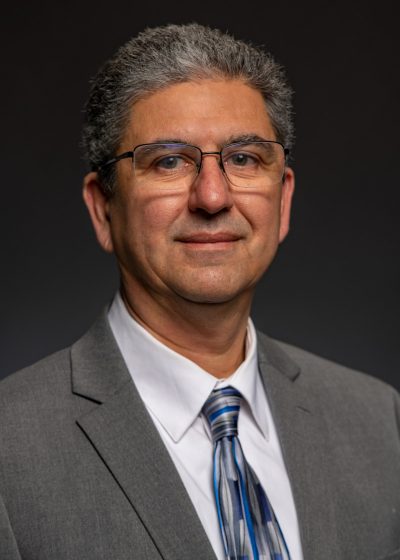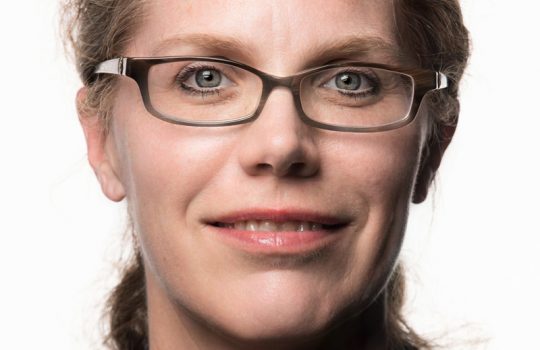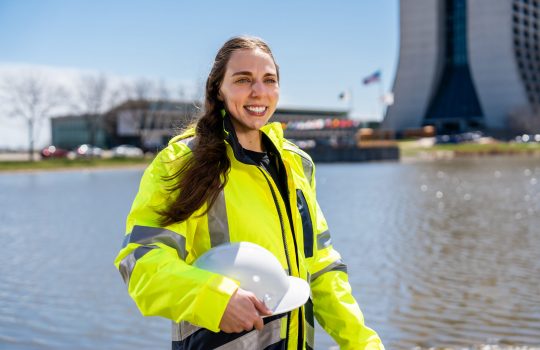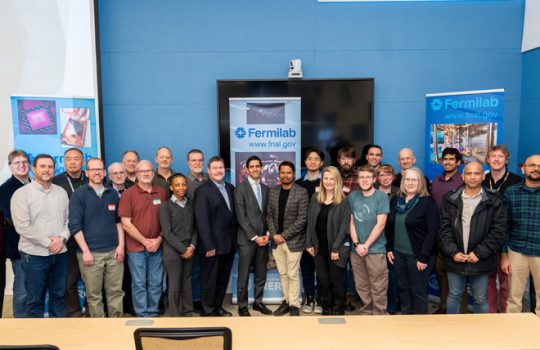While Mauricio Suarez is new to Fermilab — he started at the lab on Jan. 21 — he is a veteran in the area of technological innovation. After earning his Ph.D. in chemistry at the University of Illinois at Urbana-Champaign and completing a postdoc under Nobel laureate Jean Marie Lehn, Suarez entered the private sector, working as a bench chemist at BP in Naperville, Illinois. He obtained an MBA from the University of Illinois after that, and from there moved into the innovation arena, working in licensing technology and creating research collaborations. He worked at the American Type Culture Collection (also known as ATCC, probably the oldest and largest bank of biologicals in the world), University of Wisconsin, University of Nebraska, Syngenta Seeds and General Mills.
Now he is the Fermilab head of the Illinois Accelerator Research Center and deputy head of technology development and industry engagements.
“In all these places I played the same game but with a different T-shirt, and the name of the game is moving technology into the marketplace,” Suarez said. “Between licensing a probiotic bacteria from ATCC to a food company, or negotiating an agreement between General Mills and National Renewable Energy Laboratory about a seed sorter to improve the quality of a breakfast cereal, or licensing conductive concrete from University of Nebraska that can be used in electromagnetic-pulse shielded buildings, the goal has remained the same.”
What is your role at Fermilab?
I’m the acting deputy head of technology development and industry engagements, and I also run the laboratory’s Illinois Accelerator Research Center. At IARC, we look for industry collaborations that will advance the areas where Fermilab has significant expertise and that have commercial potential.
What are your goals as deputy head of technology development and industry engagements?
I work in three separate but related buckets of activities.
The first is technology development. In this bucket I have two main goals. My first goal is for Fermilab to develop a compact superconducting electron accelerator for industrial use. My efforts toward this goal continue the great work done by my predecessor, a scientist named Bob Kephart, and my colleague Cherri Schmidt, who heads the Fermilab Office of Partnerships and Technology Transfer, as well their respective teams. My second goal in this bucket is to define a technical area — in addition to the compact accelerator — in which IARC can develop a Fermilab expertise into an innovation of interest to industry. Will this second area be detectors, artificial intelligence, additive manufacturing or something else? Stay tuned.
The second bucket has to do with the industry partnerships needed to advance bucket one. Partnering with industry helps us focus on real, specific industry needs.
The third bucket deals with enhancing the entrepreneurship spirit at Fermilab and connecting Fermilab with the entrepreneurial ecosystem in Chicago. That includes the University of Chicago, mHUB and P33, among others. IARC will be working in this bucket with the Office of Partnerships and Technology Transfer.
You mention the Fermilab Office of Partnerships and Technology Transfer. What are its responsibilities, and how do they differ from IARC’s?
IARC and the Office of Partnerships and Technology Transfer, or OPTT, are two separate groups that work very closely together. We are neighbors in the IARC office building, and we are both led by Tim Meyer, who is the Fermilab acting head of technology engagements.
OPTT works in identifying and protecting intellectual property and in managing the research agreements between Fermilab and third parties. IARC looks for industry collaborations that will advance the buckets I mentioned earlier. Once we identify a partnership, IARC works with OPTT in formalizing the collaboration, just like any other group at Fermilab.
What laboratory-industry projects are you most excited about?
There are three IARC-industry activities that I find especially exciting. With an industry partner, we are exploring the possibility of eliminating persistent contaminants like fluorocarbons in water with an electron beam. IARC is also advancing technologies such as contact cryogenics in order to make real the concept of an economical, high-power, compact, superconducting electron accelerator that solves industry problems. And third, we have a low-power, copper electron beam machine, called A2D2, available to third parties for testing to see if it is a practical approach to solve their problems. By conducting tests using A2D2, potential customers can determine whether their problems can be addressed by the more sophisticated compact superconducting accelerator.
How do you describe leadership?
To me, leadership is an adjective that describes an action and not necessarily a person. A person demonstrating leadership in one instance may miss the target at the next opportunity, and that’s OK if we strive to act with leadership in a consistent manner.
Leadership is truth-telling with a positive, can-do vision and attitude. Truth-telling without a positive vision can be paralyzing. A positive attitude without truth-telling can be manipulative and damaging to trust.
How did you get into the technological innovation game?
I would describe myself as a scientist at heart who fell in love with innovation. I moved from the discovery phase into the technology innovation phase about 20 years ago. For me, “innovation” is when a discovery affects the lives of others through products and services. And technical innovation — a great field to be in — is the intersection of technology, business and the law.
What does it take to work in this field?
To work in technical innovation, one doesn’t need to be the technical expert on all inventions but rather needs to be able to have a conversation with the technical experts about what makes their discovery new and the benefits that it provides — faster, cheaper, more convenient. One needs to understand customer needs and markets. It is also useful to have some knowledge about intellectual property law, like law pertaining to patents, trademarks or copyright. It is imperative to make sure that technical experts, attorneys, business development people and others are aligned in moving the discovery into products and services. It works best when everyone pushes toward the same goal of converting the discovery into innovation, a process that I find to be a bit magical, akin to alchemy.
Innovation is important for many industries, and it is crucial for national competitiveness. Innovation is hard and requires the participation of multiple players. I believe in the importance of the triple helix — academia, government and industry — to move technology commercialization forward. This is especially true for early innovation rooted in science and engineering, which we call “deep tech”. I have participated in two rails of the triple helix, and I’m excited to be part of a national lab today and complete the loop with the third rail.
What excites you about working at Fermilab?
Fermilab is trying to solve problems at the frontier of particle physics. Scientists and engineers develop technology and solutions to fulfill science’s needs under extremely difficult constraints. The question to me is: Is there anyone out there who could use the technology developed to solve a societal problem outside of what it was designed for? Does it have commercial application?
If an individual or company is interested in engaging with Fermilab to develop a technology, how should they go about starting that conversation?
That’s easy. Give me or any of the exceptional members of IARC a call. You can find our contact information on our website.
We also attend applications-related conferences and interact with companies there. Plus, we independently identify possible industry partners and connect with them to educate them about who we are and what we can do for them and their industries.
Fermilab’s industrial-partnership work is supported by the Department of Energy Office of Science.
Fermilab is supported by the Office of Science of the U.S. Department of Energy. The Office of Science is the single largest supporter of basic research in the physical sciences in the United States and is working to address some of the most pressing challenges of our time. For more information, visit science.energy.gov.




